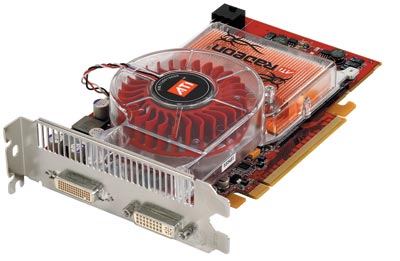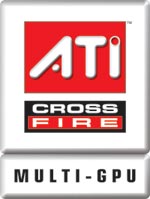1. Page 1
Founded in 1985, Canadian ATI has been in the business for 20 years now. The
company has specialized in graphics technology, supplying products to the traditional
PC market as well as the Consumer Electronics market covering mobile phones,
TV sets and Set-top Boxes.
At the core of ATI’s business is the PC, for which ATI delivers leading technology powered
by ATI’s Radeon graphics processors. For notebooks, ATI’s
Mobility Radeon line of graphics processors for mobile products, delivers technology
that offers more features without sacrificing performance, power or mobility.
In addition, ATI’s consumer products include the Imageon line of processors
for cell phones and Xilleon processors for the Digital Television market. ATI
also supplies graphics processors for the Nintendo GameCube and has future
technology agreements with both Nintendo and Xbox.

The company has more than 2,500 employees across its headquarters in Markham,
Ontario, and offices in the Americas, Europe and Asia. ATI has research and
development facilities in California, Florida, Massachusetts, Ontario and Pennsylvania
and manufactures its products in Canada and Taiwan.
Lately, the company has been in the foreground with announcements of
forthcoming and very promising graphics cards, the introduction of the
CrossFire technology, as well as the cooperation of the company with Microsoft
over the next generation OS Vista and the Xbox 360 gaming console.
CDRInfo had the chance to talk with ATI's Technical PR Manager for Europe, Mr Rene Froeleke, in an interview that reveals upcoming development plans from the company.

2. Page 2
What is the market share for ATI? In which way do you believe that
upcoming products (CrossFire, etc) will affect your OEM and retail sales?
The market share numbers vary by product segment. For the PC Desktop
space, we are currently leading the segment of discrete graphics (i.e. without
chipset integrated graphics) with a share of 56% according to the Q2/05 numbers
from Mercury Research. And of course, we try to freshen up the market with every
new product or technology, be it CrossFire or our upcoming graphics chips which
will be launched very soon.

The release of CrossFire had been scheduled for August. What were the reasons for its delay?
We came across some issues during our QA testing, and as we wanted to
supply the most complete dual-GPU solution, we wanted to make sure that we
understand the root cause of these problems. Once identified, we had to test
it against all possible combinations of graphic adapters.
Could you provide us with an update of the release dates for all
three 90nm R500 desktop chips (R520, RV530, and RV515)?
Sorry, I can’t give you the exact release date, but it will be
very soon…
What are the main reasons that prompted ATI to move to the 90nm production
technology? Have you come up with any problems with the silicon fabrication
at 90nm?
The main reasons when moving from one manufacturing process to the next
are essentially always the same, you can get more transistors onto the same
space and run the chip at higher clock speeds. We had some problems with 2 out of 4 chips manufactured using 90 nanometer, but these were
not related to the process technology or our manufacturing partner.
3. Page 3
Apart from the support for Shader Model 3.0, what are the main enhancements
made in the R520 chipset? (New graphics architecture, memory controller)
And again I am sorry, but we can’t tell your readers about the
upcoming technology before its announcement.
Rumors have it that both R520 and RV530 will run at 600 MHz. Does the
extra MHz make the difference in this class of graphics cards?
Sorry, I can’t comment on unannounced products.
Have you removed any planned features from the R520 in order to reach
its final version that will appear on the market?
No, we did not have to remove any features from the R520 or any other
of our upcoming products. While this was suggested by some rumors, cutting
the feature set of our next generation products was never up for discussion.

How does CrossFire compare with SLI in terms of performance?
Obviously, performance always depends on the application that is used
to measure it. CrossFire can accelerate all the games all the time, meaning
that even older games or games that were not in the top 10 list will be able
to take advantage of CrossFire.
However, a game's performance can of course also be limited by the system processor.
In that case, more graphics power does not get you more frame rate. For these
cases, CrossFire has the advantage of SuperAA, meaning that the user can enable
higher picture quality if performance can not be improved.
Generally, if compared on the same price level, we are confident that CrossFire
has the better price/performance ratio than our competitor’s product.
Is ATI planning to release a Crossfire board with x16 slots and the
corresponding extra PCI-Express lanes?
We are not at the end with our CrossFire development; there is lots more
to come. A mainboard with two “true” PCI Express x16 slots is only
one of the developments, but there are more.
How would you compare the overclocking capabilities of the R520
with those offered by NVIDIA’s 7800 series?
This is something I would like to leave to the overclockers out there,
but please remember that we have chosen the 90 nanometer process for a reason… :)

4. Page 4
Are there any differences between the RV515 chip for the PC and the GPU that
will be used for the Xbox 360?
Yes, there are huge differences. The Xbox 360 GPU is designed for the
Xbox 360 only, and it is not comparable to any existing or soon the be launched
PC products.

Could
you briefly describe the differences between the Xenon chipset and NVIDIA’s RSX chipset which is planned for Sony’s
Playstation 3?
Sorry, but all I know about the Playstation 3 GPU so far is limited to
the official information and a lot of rumors, and I would not like to make
this kind of comparison based mainly on rumors. I am afraid that we will have
to wait with these comparisons until we know the specs of both products.
How is efficiency affected by a single unified pipeline for pixel
and vertex (Xbox 360)?
The Xbox 360 GPU is the only GPU with a unified shader architecture.
Unified Shaders offer more flexibility, essentially providing more pixel or
more vertex shading power when needed. This does of course have an effect on
efficiency as you don’t have vertex shader units running idle while the
pixel shaders are all under heavy load. And of course, it has the advantage
that shader programs that need to calculate vertex and pixel operations do
not have to go from one shader unit to another, so the performance of features
such as Displacement Mapping improve tremendously with a unified shader architecture.
Microsoft’s Xbox 360 will be equipped with an eDRAM
Die unit,
connected to the GPU. What is the functionality of this unit?
The GPU has access to 10MB of eDRAM dedicated to graphics. These 10MB are
not simply for storage, but also take over some of the graphics processing
tasks required for Anti-Aliasing, Z, Alpha or Stencil. So essentially, we are
talking about intelligent eDRAM, rather than just a big chunk of memory for
storage of data.
According to sources, Microsoft will work with NVIDIA in order to
emulate Xbox's Intel
CPU on the 360's multiple IBM PowerPC cores, and will also emulate the
NVIDIA chip to some extent on the ATI graphics chip
in the 360. What are your comments on the backwards
compatibility issues of
the Xbox 360 in connection with the earlier Xbox game titles?
This is a question that I would not like to get into. While I am sure
that we work with Microsoft on this, it is mainly a Microsoft project for which
I can’t supply comments as I don’t have the full picture. Microsoft
or a game developer would be the better spokesperson on this.
5. Page 5
ATI has announced an incorporated Silicon Image. The SiI 1390 transmitters
are claimed to be solutions designed
to interface directly to the video and audio interfaces of PC platforms to
enable secure
access to high definition content. What is the main reason that has driven
ATI and NVIDIA to equip
graphics cards with an HDMI interface?
There are currently no graphics adapters I know of that would have a HDMI
interface. Although some reference designs have appeared, so far, we have not
released a board that incorporates a HDMI interface (and I am also not aware
that any of our partners would have one).
The HDMI interface supports both digital audio and video. Will a
future scenario include graphics cards which would also support audio?
Please see my answer in the previous question. In addition to that, I
could not talk about any future plans, I can really only talk about products
that are available now or hint at upcoming products.
Would the use of a dual-core GPU concept, like the one used for PC
CPUs be a reasonable course of action for future graphics card?
The concept behind dual-core CPUs is to parallelize the workload and
split it into two or more threads. In graphics processing, we have been using this
kind of concept for years, i.e. we are running several pipelines in parallel.
What about a dual GPU on a single PCB? Should we expect performance
comparable to a CrossFire configuration?
Yes, two GPUs on one PCB would essentially offer the same performance
as a CrossFire configuration. In fact, there are some advantages if both GPUs
could be integrated on one PCB, but there are also a lot of drawbacks such
as powerdraw, space, etc.

Are we going to see four or even more display card solutions on a
singe board, after CrossFire?
Our FireMV line of products already support up to 4 Monitors on a single
graphics adapter. However, most users with the desire to drive two, three or
four monitors usually don’t use these systems for gaming but for applications
for example in the stock market, banking, etc.
6. Page 6
Windows Graphics Foundation 2, the version of DirectX that will ship
with Vista will be designed and based on the idea that the graphics card will
have unified vertex and pixel pipelines. What is the latest progress involving
the cooperation between ATI and Microsoft for the Vista OS?
Generally, while the API sets the feature set and defines how it can
be used, it does not dictate to us how to integrate this feature set. There are
some features in this upcoming API that we believe can be done more efficiently
with a unified shader architecture, but such an architecture is not an absolute
must have.
Our cooperation with Microsoft, the supplier of Microsoft Vista, as the
supplier of the next generation API, as the supplier of the Xbox 360 etc. is
very good. Not only because of one or the other, but because we know that only
a good cooperation ensures the development of truly feature rich products.
What about the current Catalyst support for TCI (Trusted Computing
Initiative)?
Our Catalyst drivers support Microsoft’s COPP API which includes
support for Macrovision, CGMS-A and HDCP.
Does ATI use a third party chip to implement the required decryption
for HD-DVD/Blu-ray playback under the Vista OS?
So far, we do not offer graphics adapters with HDMI output. However, there
are of course plans to offer this feature and there are different possibilities
to integrate HDCP and thus enable the playback of HDCP material, but at the
moment I can’t say which way we will go.
Are there any plans for Blu-Ray playback support under Vista?
We will offer support for H.264 decoding and the flexibility of our video
engine allows us to adapt new decoding algorithms when necessary.
ATI used to cooperate with Texas Instruments on chips in the past.
What is the current status of the partnership with this company?
We cooperate with a lot of companies on a lot of projects, and it is
quite possible that we did and still do cooperate with TI, but I would not
be able to comment on the current state of our working relationship with them.
What should we expect after the Xbox 360 and CrossFire?
More new products with more new features and more performance. As always
in the PC business, we are constantly researching new products and technologies.
But to talk about them now would take away a lot of the fun, wouldn’t
it?
